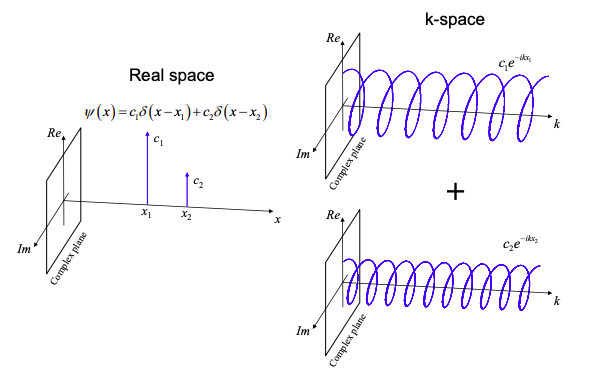1.9: Linear Combinations of Waves
- Page ID
- 49372
Next, we consider the combinations of different complex exponential functions. For example, in Figure 1.9.1 we plot a wavefunction that could describe an electron that equiprobable at position \(x_{1}\) and position \(x_{2}\). The k-space representation is simply the superposition of two complex exponential functions corresponding to \(x_{1}\) and \(x_{2}\).\(^{†}\)
\[ \psi(x)=c_{1}\delta(x-x_{1})+c_{2}(x-x_{2}) \Leftrightarrow A(\omega) = c_{1}e^{-ikx_{1}}+c_{2}e^{-ikx_{2}} \nonumber \]

We can also generalize to an arbitrary distribution of positions, \(\psi(x)\). If \(\psi(x)\) describes an electron, for example, the probability that the electron is located at position x is \(|\psi(x)|^{2}\). Thus, in k-space the electron is described by the sum of complex exponentials \(e^{-ikx}\) each oscillating in k-space and weighted by amplitude \(\psi(x)\).
\[ A(k)=\int^{+\infty}_{-\infty}\psi(x)e^{-ikx}dx \nonumber \]
You may recognize this from 6.003 as a Fourier transform. Similarly, the inverse transform is
\[ \psi(x)=\frac{1}{2\pi}\int^{+\infty}_{-\infty}A(k)e^{ikx}dk \nonumber \]
To convert between time and angular frequency, use
\[ A(\omega) =\int^{+\infty}_{-\infty} \psi(t)e^{i\omega t}dt \nonumber \]
and
\[ \psi(t)=\frac{1}{2\pi}\int^{+\infty}_{-\infty} A(\omega)e^{-i\omega t}d\omega \nonumber \]
Note that the factors of \(\frac{1}{2\pi}\) are present each time you integrate with respect to k or \(\omega\). Note also that when converting between complex exponentials and delta functions, the following identity is useful:
\[ 2\pi\delta(u)=\int^{+\infty}_{-\infty} \text{exp}[iux]dx \nonumber \]
\(^{†}\)Note that this wave function is not actually normalizable.


